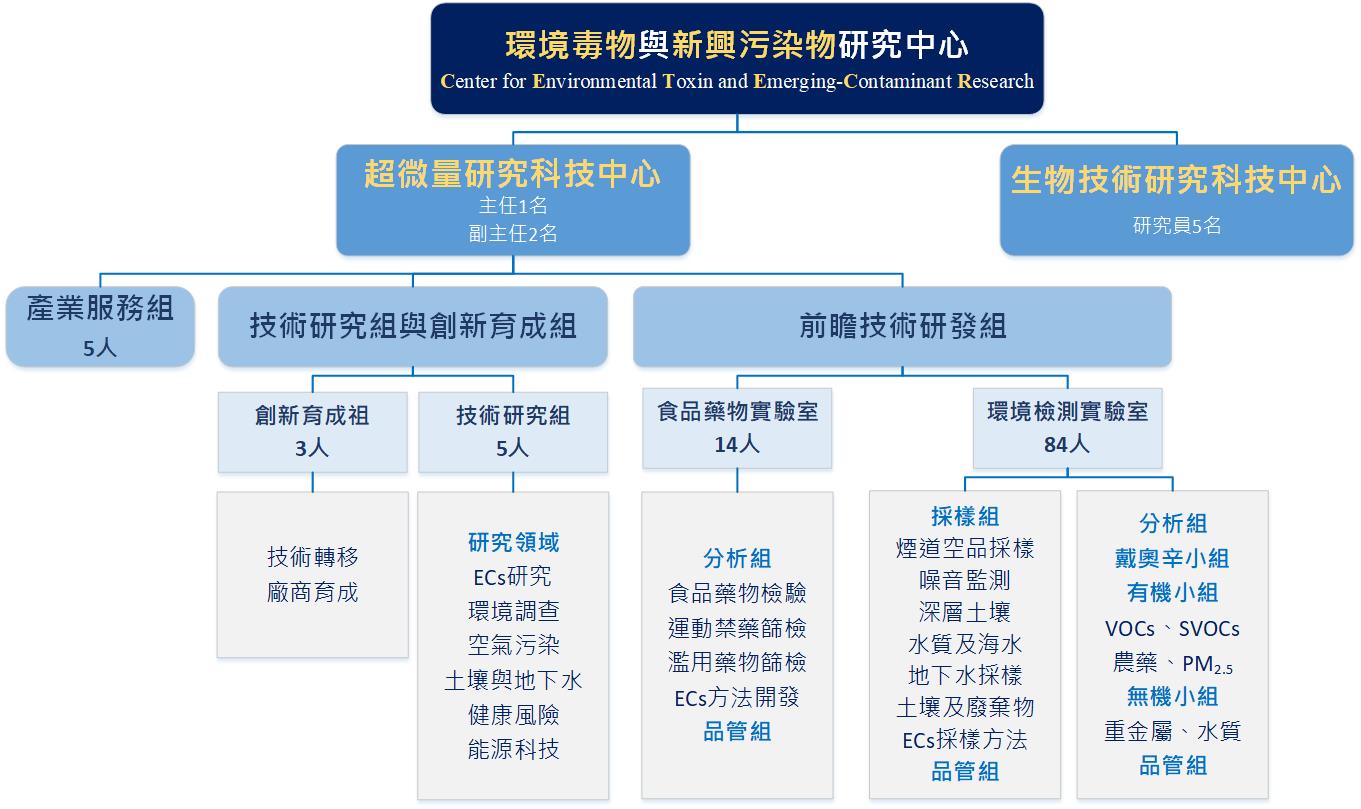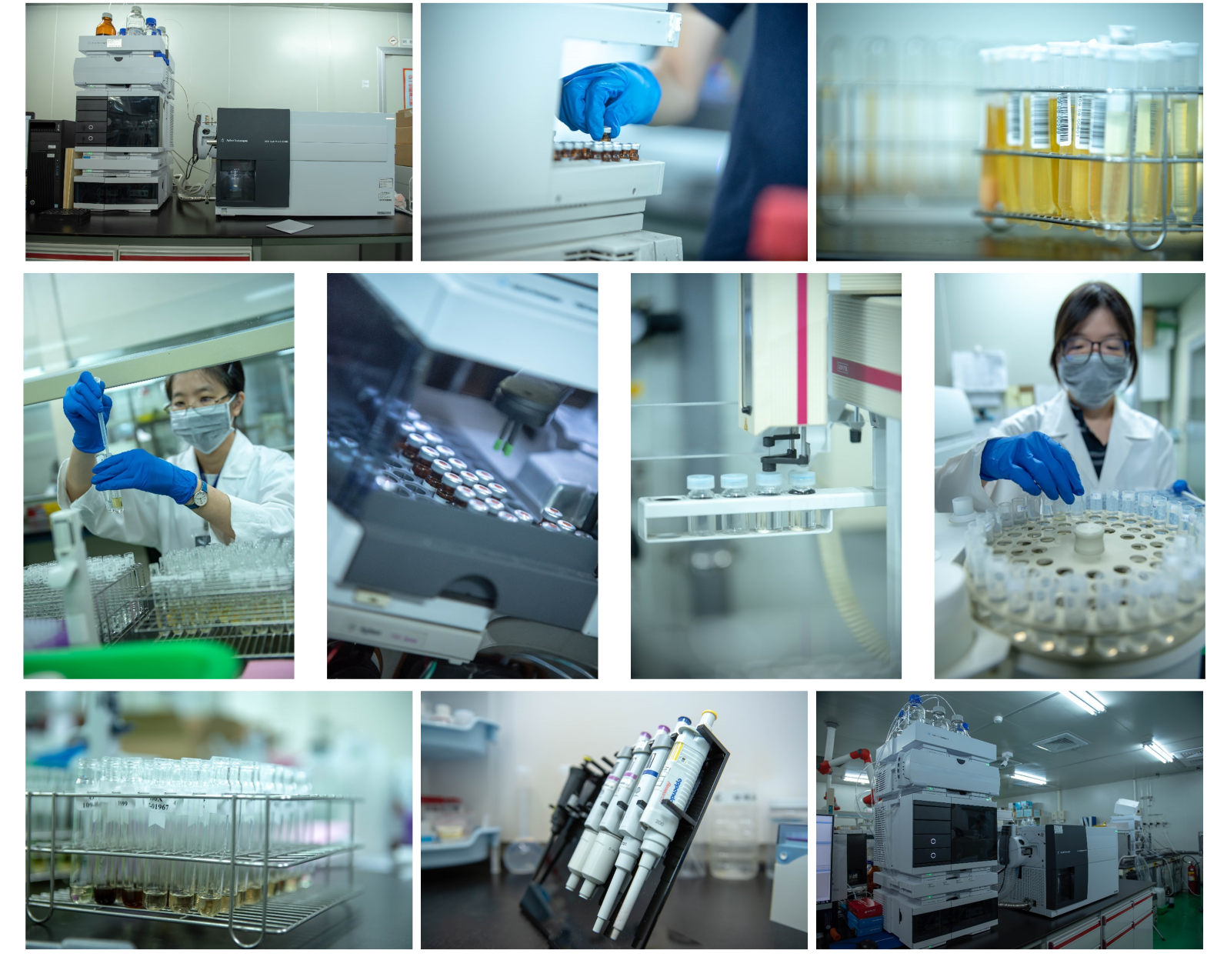
About Us
- 關於我們 -
中心簡介
原超微量研究科技中心於一年內積極成長轉型為環境毒物與新興污染物研究中心,目前專任、約聘及兼任人員共計129員,由一資深教授擔任中心主任,負責總體發展營運規劃,轄下二位副主任,分別負責本校各單位與中心之校務合作與聯繫,以及各工作小組、實驗室及行政人員間溝通協調。
本研究中心包含原超微量研究中心以及生物技術研究科技中心,其轄下單位以環工、化工、食品等背景人才分別組成技術研究組、創新育成組、環境檢測實驗室、食品藥物實驗室及行政組。並透過延攬國際優秀人才暨年輕優秀人才挹注整合成立技術研究及創新育成組和前瞻技術研發小組。
 

 
基於聯合國永續發展之17項目標(Sustainable Development Goals, SDGs)中,6項「永續環境」重點發展項目,正修科技大學自1999年成立超微量研究科技中心 ,持續投入永續環境研究,包括空氣、廢棄物、水及飲用水、土壤與地下水、環境影響評估、健康風險評估、食品與禁藥檢驗及再生能源技術等領域,為國內重要環境污染物研究中心,更為我國行政院環境保護署(EPA)、衛生福利部食品藥物管理署(FDA)及全國認證基金會(TAF)之重點認證實驗室,認證檢驗項目包含環境檢驗655項、食品檢驗395項、水中藥物檢驗40項及國際奧林匹克委員會所屬世界反運動禁藥機構(WADA)管制之六大類192項(統計至2020年)。
,持續投入永續環境研究,包括空氣、廢棄物、水及飲用水、土壤與地下水、環境影響評估、健康風險評估、食品與禁藥檢驗及再生能源技術等領域,為國內重要環境污染物研究中心,更為我國行政院環境保護署(EPA)、衛生福利部食品藥物管理署(FDA)及全國認證基金會(TAF)之重點認證實驗室,認證檢驗項目包含環境檢驗655項、食品檢驗395項、水中藥物檢驗40項及國際奧林匹克委員會所屬世界反運動禁藥機構(WADA)管制之六大類192項(統計至2020年)。
我國高科技及生醫產業蓬勃發展,各類「新興污染物」排放與環境衝擊成為重要課題,國內環檢產業雖普及多年,但對於新興污染物之檢驗技術仍未臻成熟,欠缺全面性環境衝擊影響與健康風險評估能力,對於潛在污染產生者亦須加強諮詢、輔導與改善。因此,本研究中心預計逐步轉型成為具代表性之「環境毒物與新興污染物研究中心 (Center for Environmental Toxin and Emerging-Contaminant Research, CENTER)」,持續跨校及跨域合作,開發前瞻分析技術,因應未來新興環境與食安問題。
先進、完善之實驗室空間與設備
本研究中心成立於本校行政大樓1、2、4、5及10樓及綠屋分別設有實驗室。
1.技術研究組與創新育成組:包含一可容納15名研究人員之辦公室、一間會議室以及本校管理之所有會議室、教室及室外等公共空間。
2.環境檢測實驗室:包含戴奧辛實驗室2間、潔淨室(粒狀物、ICP/MS、有機汞)3間、有機分析實驗室2間、無機分析實驗室2間、環境採樣準備室2間。
3.食品藥物實驗室:包含2實驗室,其中之一為禁藥分析管制實驗室。
4.本研究中心重要設備如下:
|
設備名稱 |
式 |
設備名稱 |
式 |
|
高解析氣相層析/高解析質譜儀(HRGC/HRMS) |
5 |
七位數微量天平系統 |
1 |
|
穩定同位素氣相層析質譜儀(IRMS) |
1 |
戴奧辛連續自動採樣系統(AMEA) |
1 |
|
串聯式氣相層析質譜儀(GC/MS-MS) |
2 |
空氣品質監測車 |
3 |
|
氣相層析質譜儀(GC/MS) |
20 |
PM2.5、PM10、TSP採樣設備 |
19 |
|
氣相層析電子捕捉偵測器(GC/ECD) |
3 |
PS1高量採樣器 |
10 |
|
氣相層析火焰離子化偵測器(GC/FID) |
5 |
微生物採樣器 |
1 |
|
串聯事液相層析質譜儀(LC/MS-MS) |
7 |
二氧化碳監測器 |
1 |
|
高效能液相層析儀(HPLC) |
3 |
空氣採樣空瓶 |
40 |
|
感應耦和電漿質譜儀(ICP/MS) |
2 |
空氣臭味採樣器 |
2 |
|
感應耦和電漿園子發射光譜儀(ICP/OES) |
2 |
煙道戴奧辛、六價鉻及粒狀物採樣系統 |
6 |
|
園子吸收光譜儀(AA) |
2 |
煙道SO2、NOx、CO2、CO、O2監測儀 |
1 |
|
離子層析儀(IC) |
2 |
煙道碳氫化合物自動監測儀 |
1 |
|
總有機碳分析儀(TOC) |
2 |
深層土壤採樣儀 |
1 |
|
手動總汞分析系統(CVAFS) |
1 |
地下水採樣系統 |
3 |
|
流動注入分析儀(FIA) |
2 |
底泥艾克曼採樣器、岩心採樣器 |
2 |
|
分光光度計(UV) |
2 |
海水十合一偵測器 |
1 |
|
土、水中汽柴油揮發性有機物進樣濃縮裝置 |
7 |
洋流海象監測儀 |
1 |

全面性專業服務
本研究中心多年來持續投入環境相關研究領域,包含持久性污染物、環境調查及衝擊評估、土水污染鑑定、空污溯源與控制整合分析、環境流行病學與健康風險評估、替代能源與食品檢測技術。 戴奧辛及持久性污染物:戴奧辛及持久性污染物檢測分析技術為本研究中心研究強項,每年均參與國際比對(如下圖),2016年於80個國際實驗室中,飛灰戴奧辛分析準確度第2名,飼料與底泥戴奧辛精密度第1、2名。建立國內戴奧辛資料庫。
本研究中心於持久性有機污染物檢測技術與國際實驗室之比對成果
於2012~2015年參與美國太空總署(NASA)七海計畫(Seven SouthEast Asian Studies Mission, 7-SEAS),獲得污染物長程傳輸重要資訊。本研究中心亦投入開發持久性污染物排放減量技術,成果發表於Environ. Sci. Technol.等頂尖期刊。
●環境監測調查及衝擊評估:
包括了環境空氣品質、環境噪音、環境振動、低頻噪音調查、海域水質與海域底質採樣分析、海域生態與陸域生態調查(含海底攝影)等。更致力於海峽兩岸大型研究,與中國極地考察辦公室、國立海生館、東華大學組成科學考察隊,藉「雪龍號」赴南極勘研究,藉由調查南極土壤及動物環境介質,分析持久性污染物全球傳輸宿命,並意外共同發現二類海洋無脊椎動物新物種
 
●空氣及土水污染溯源整合分析:
設計空氣及土水污事件實地調查、監測、成分比對、模式模擬及分子生物技術方法,研究污染流布及來源分析,並培育出5位土壤調查評估人員。成果發表於Sci. Total Environ.等國際頂尖期刊。
●環境流行病學與健康風險評估:
研究特定地區之污染排放對於周界居民之健康風險影響,調查民眾血液戴奧辛與多氯聯苯濃度、尿液中重金屬濃度,並依據健康風險評估技術規範,確認不同暴露途徑之致癌風險,提供對致癌物質排放減量之建議。
●替代能源技術:
研發含水ABE發酵產物及回收含溶劑廢水添加於柴油及重油,減低純化成本,並降低粒狀物(PM)、氮氧化物(NOx)及多環芳香烴化合物(PAHs)排放,有效改善NOx-PM Trade-off的問題。研究成果發表於Appl. Energ.等頂尖期刊。
 
●空氣污染物多元控制技術:
整合觸媒氧化還原與過濾技術,透過觸媒載體結構改質、觸媒配方改良及操作參數最佳化,得到多元污染物處理模組,期望去除煙流中戴奧辛、PM2.5、NOx、SO2及VOCs等污染物,已得到良好之戴奧辛與PM去除結果。
●食品與禁藥檢測技術:
發展食品八大營養成分、防腐劑、甜味劑、非法添加物(二甲基黃、丁基二酸等)、微生物、重金屬等檢驗技術,提供國營事業、各縣市農會、食品公司、學術機構及檢測業者進行技術服務與專業諮詢。
●毒品運動禁藥檢測技術:
建立26項藥物(新興污染物)、國際奧林匹克委員會192項運動禁藥及動物用藥等檢驗技術,為國內唯一受到中華奧林匹克委員會委託之運動員禁藥檢驗實驗室,並持續協助司法單位與體育協會進行尿液毒品與禁藥篩檢。